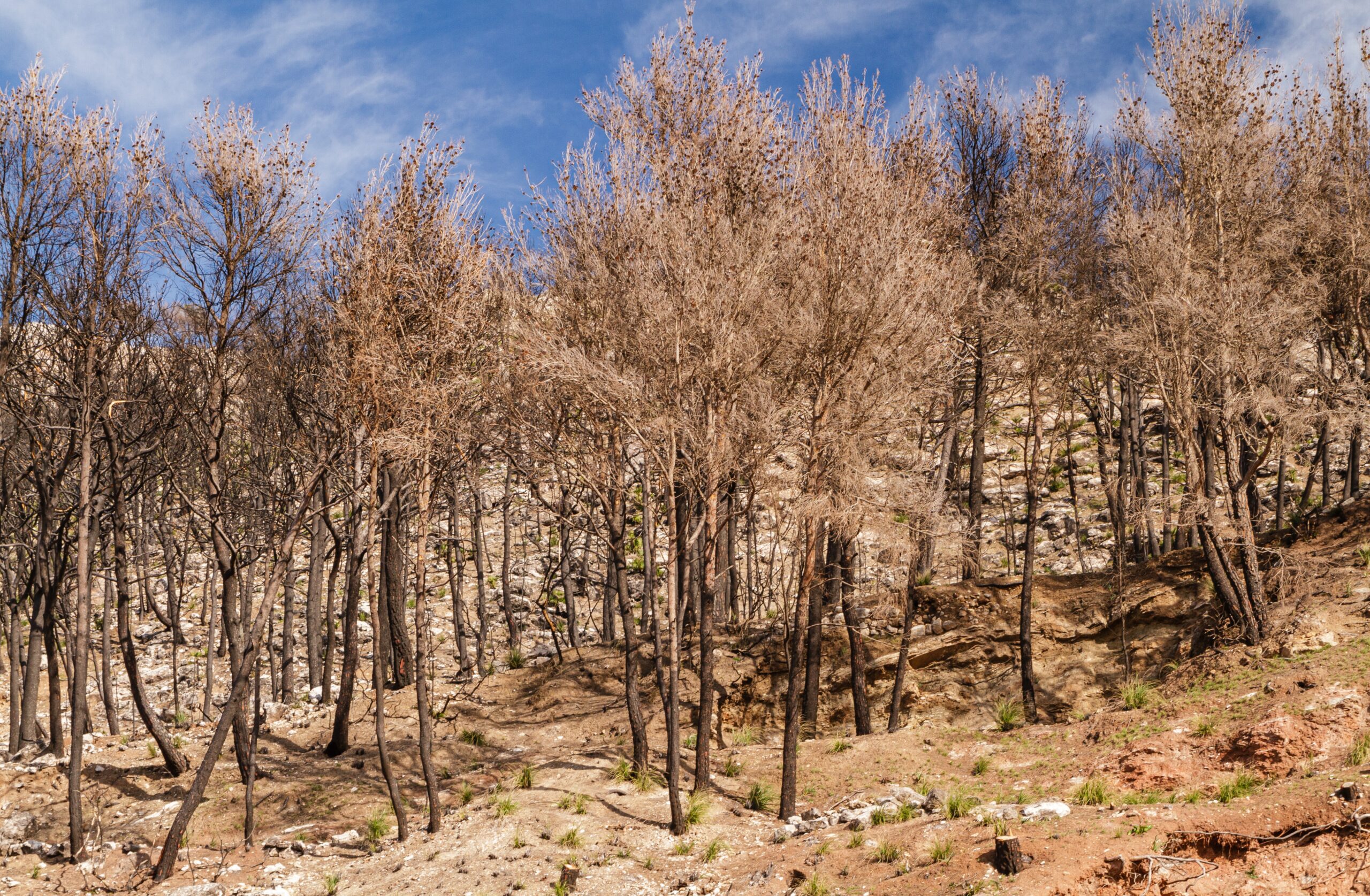For the last decade, Andreas Malm has been writing about climate change in a radical way. He has outlined a theory of “fossil capital” as a method for understanding the driving force of climate change, analyzed climate change through the lens of racial justice, and has argued for a diversity of activist tactics as a response to ecological collapse. The Canadian social activist and writer Naomi Klein has called Malm “one of the most original thinkers” regarding climate change, and his theoretical writings about activism have even inspired action films like the 2022 thriller How to Blow Up a Pipeline. However, Malm’s latest offerings Overshoot: How the World Surrendered to Climate Breakdown and The Long Heat: Climate Politics When It’s Too Late approach the topic of climate change through a different lens.
Rather than articulate a new way to understand and fight against the impending climate disaster, Malm and his coauthor Wim Carton look at how our governments, corporations, and institutions have tacitly accepted that we will exceed at least 1.5°C of global warming and, amidst the warning signs of impending climate catastrophe, have carried on in a business-as-usual fashion. They call this state of affairs the overshoot conjecture, or climate overshoot, and define it as:
the period when officially declared limits to global warming are exceeded – or in the process of being so – and the dominant classes responsible for the excess throw up their hands in resignation and accept that intolerable heat is coming… Overshoot is here not a fate passively acquiesced to. It is an actively championed programme for how to deal with the rush into catastrophe: let it continue for the time being, and then we shall sort things out towards the end of this century.
In other words, our fight against climate change has been fought, and we have lost.
The Challenge of Climate Overshoot to Eco-Buddhism
Malm and Carton begin their book with a question: “what do we do when catastrophic climate chaos is a fact?” Indeed, this is a major question that Buddhists, especially those in the eco-, green, or engaged Buddhist camp, must begin asking ourselves.
Catastrophic climate chaos has become a fact. Wildfires, heat waves, ice storms, hurricanes, and other once-in-a-generation disasters have become near-yearly events thanks to anthropogenic climate change. In the midst of these effects of our climate overshoot paradigm, what is a Buddhist to do?
The Books
Modern Buddhists may be aware of the collections Dharma Gaia and Dharma Rain (published in 1990 and 2000 respectively), which brought together teachers and scholars to talk about how Buddhist practice can adapt to the threat of climate change, including Thich Nhat Hanh, His Holiness the Dalai Lama, Gary Snyder, Sulak Sivaraksa, and Joanna Macy. These teachers were writing at a time when human activity could actually change to address pressing ecological issues, and many of these writings reflect a hope that Buddhist thought can contribute to this change.
Since then, a variety of books have been published in the same vein. Stephanie Kaza’s Green Buddhism: Practice and Compassion in Uncertain Times collects a variety of the pioneering eco-Buddhist thinker’s essays to show how compassionate attention and novel practices like having conversations with the trees can allow us to foster ecological consciousness. Likewise, Christopher Ives’ twin books Zen on the Trail and Meditations on the Trail look at the intersections between hiking and pilgrimage and encourage readers to treat their hiking trips as both Zen and environmental practice.
In each of these books, Buddhist practice is directed to abate the possibility of ecological collapse. But are these Buddhist approaches to the natural world still viable in a time of climate overshoot? If our forests have burned down and we’re unable to hike because of the wildfire smoke in the air, do not these Buddhist engagements with the natural world become moot? This question, perhaps a hypothetical at the time of publication, has become a real point that we must address.
When I moved to Edmonton for a teaching position in 2024, I was elated to be near Jasper National Park. I had spent some summers living and working in this enchanting part of Canada, and being able to spend time there on my weekends made the idea of moving away from friends and family a little easier. But mere weeks before packing my car for the cross-country trip, news broke out that a massive wildfire had engulfed the National Park and had burned down the majority of the town. When I did visit that fall, I was struck by the devastation that catastrophic climate change had wrought. The lush conifers that had blanketed the mountain were now charred telephone poles dotting the slopes. The turquoise lakes once curtained off by the treeline were visible from the highway.
The imminence of climate change was indeed a fact. Faced with the fallout of the wildfire, I didn’t feel the desire to have a meditative conversation with these trees, and paying attention to the relationality between myself and my surrounding environment on a hike didn’t lead to some kind of beatific, compassionate disposition, but revulsion — and a reminder of the defects of samsara.
As climate chaos and extreme weather events become more pronounced, their ability to engender feelings of apathy and renunciation may likewise increase. But this kind of response to ecological collapse isn’t new — in fact, the eco-Buddhist scholar Ian Harris intimated this kind of reaction all the way back in 1994. Speaking about the critically engendered status of the black rhino, Harris writes:
For the environmentalist the potential demise of these noble creatures is a matter of sadness and concern. To counteract this possibility, measures will be taken to protect the species by mitigating the destructive forces at work in the rhino’s habitat… A Buddhist is unlikely to view things in this way… Change, dissolution, suffering and death are the hallmarks of all conditioned things. At the deepest level, what we take to be a rhino is nothing more than a complex series of momentary dharmas which have come together in a certain pattern… The rise and fall of all things, whether they be mountains or animals is part of the inexorable process Buddhists call samsara.
In other words, rather than inspire environmental action, reflecting on the potential extinction of the rhino may compel us to simply pursue Buddhist practice to escape samsara altogether.
This is the challenge posed to eco-Buddhism by our present moment of climate overshoot. Like all other conditioned phenomena, the climate is impermanent. Thus, when confronted with the reality of the climate changing and the disastrous ecological consequences that emerge from this change, a Buddhist may very well be compelled to reflect on impermanence, think about the defects of samsara, and work to distance themselves from the world in pursuit of liberation. In doing so, they might forsake any kind of engagement with ecological politics or any kind of work to ameliorate our shared climate situation. In this way it seems as though Kaza and Ives’ approaches to eco-Buddhism, while innovative and impactful at the time of their publication, might be somewhat troubled by our contemporary moment of climate overshoot. If catastrophic climate change is a reality that confronts us in our day-to-day lives, can Buddhist practice actually offer us a way to respond?
What Are Buddhists To Do?
I suggest that Buddhist teachings actually present ideal models for how to act in a time of climate overshoot. Now, perhaps more than ever, it seems as though there is nothing that can be done about climate change. Institutions are not greening, sustainability is a marketing slogan instead of an economic ethos, and more fossil fuels are being extracted than ever before. Indeed, climate change seems unstoppable, insurmountable. But so too are sentient beings innumerable, our desires inexhaustible, the dharma boundless, and the way of the buddha unattainable.
For those practicing in Mahayana contexts, these four statements are likely familiar – they consist of one half of the Bodhisattva Vow. The other half of the vow states what we are to do about the matter: Sentient beings are innumerable, I vow to save them; desires are inexhaustible, I vow to overcome them; the dharma is boundless, I vow to master it; the way of the Buddha is unattainable, I vow to attain it. In each of these cases, the scope or even the sheer impossibility of the task at hand doesn’t compel apathy, renunciation, or giving up. It is in the very face of impossibility that we commit to act.
Climate change is out of control, I vow to stop it. This is how one committed to the bodhisattva ideals should think about the inevitability of climate change and climate chaos. In the face of our impossible moment, we must commit to act. The inevitability of climate change can make one feel hopeless, this hopelessness can lead to paralysation, and this paralysation can lead to a deference to business-as-usual activities (the kinds we find responsible for climate overshoot). In her 2011 book Living in Denial: Climate Change, Emotions, and Everyday Life, sociologist Kari Marie Norgaard looks at several studies which show that “respondents with higher levels of information about global warming show less concern,” because “unless they feel able to do something about the problem, an awareness of concern or sense of responsibility would be a conflicting cognition [that creates an unpleasant feeling].” But if we approach this problem with a bodhisattva mentality, we will act in spite of the feeling that we are not able to do anything.
This bodhisattva approach to climate change has been forwarded before — David Loy’s Ecodharma: Buddhist Teachings for the Ecological Crisis forwards the archetype of the “ecosattva” as an embodiment of ecological Buddhist practice, and talks about the ecosattva vow in precisely these terms. He writes:
No matter how momentous the task of working with others to try to save global civilization from destroying itself, that is nonetheless a small subset of what the bodhisattva has committed to doing. No matter what happens, we are not discouraged — well, not for long, at least… That’s because this vow goes beyond any attachment to any particular accomplishment — or defeat. When our efforts are successful, it’s time to move on to the next thing. When they’re not successful, we keep trying — indefinitely.
So, in this moment of climate overshoot, when the negative consequences of climate change have arrived in full force, I propose that we return to the Bodhisattva Vows in order to ground our practice, act in the face of impossibility, and navigate this moment of climate overshoot.
Sentient beings are innumerable, I vow to save them.
Desires are inexhaustible, I vow to overcome them.
The dharma is boundless, I vow to master it.
The way of the Buddha is unattainable, I vow to attain it.
Climate change is out of control, I vow to stop it.


